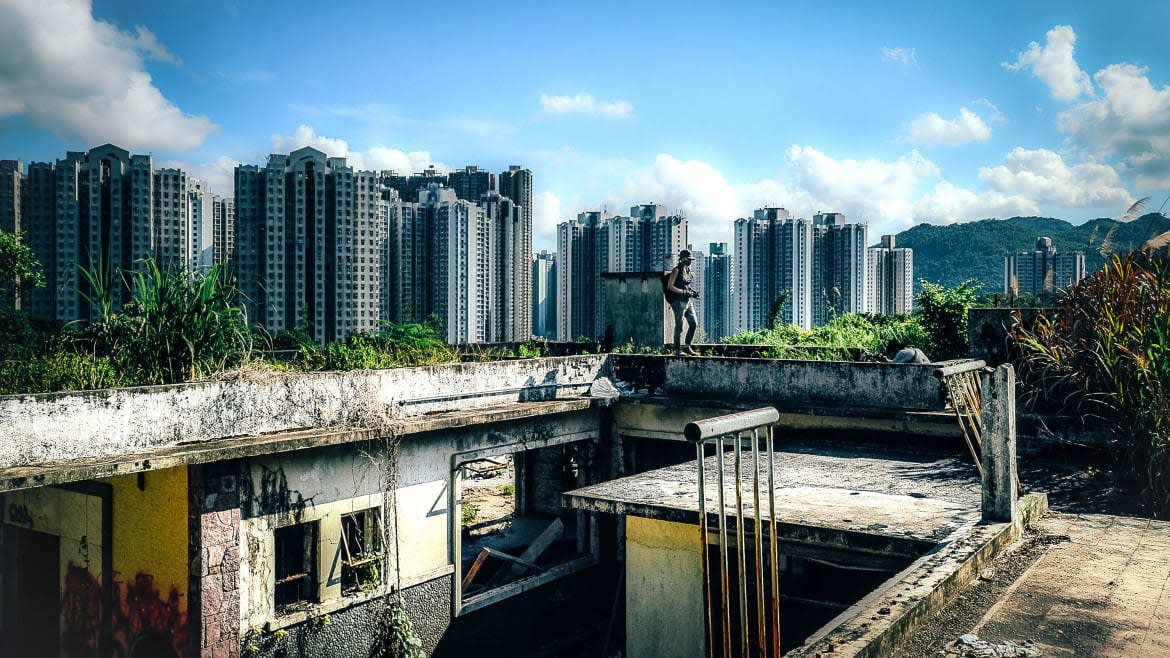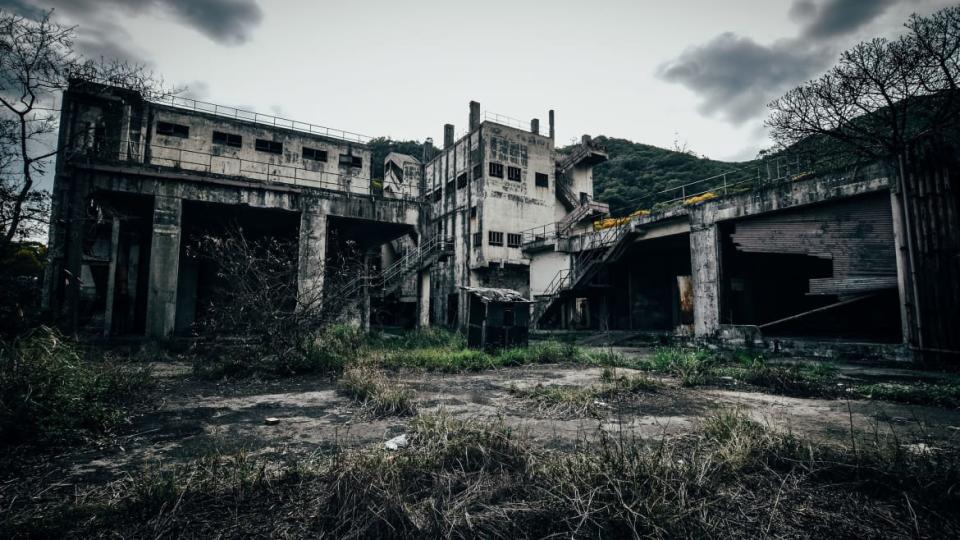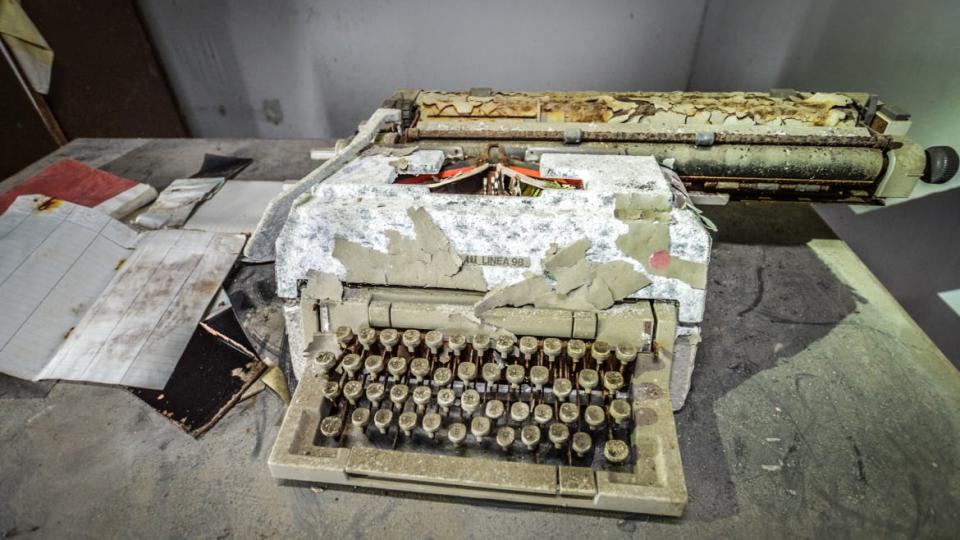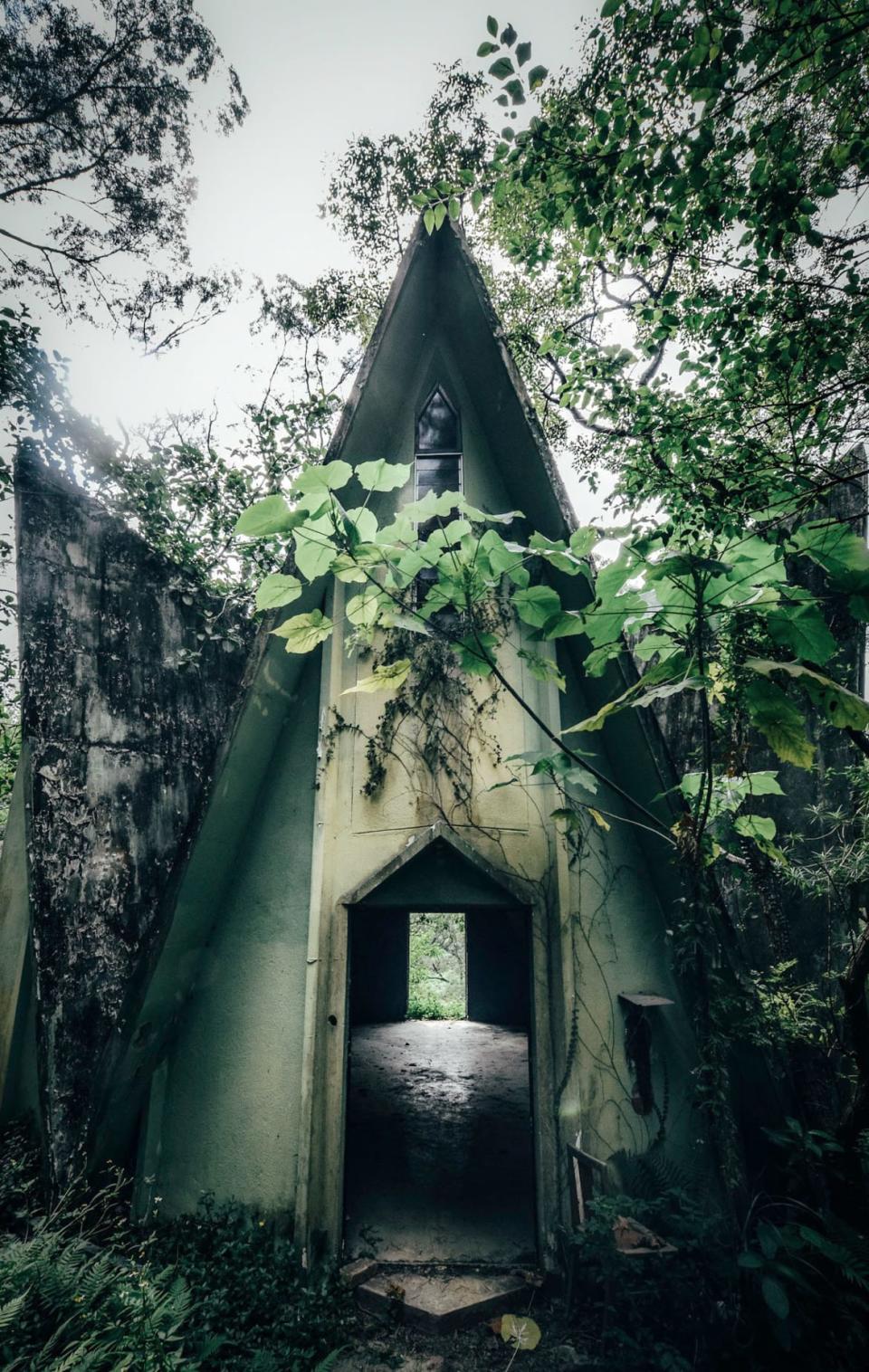These Urban Explorers Are Keeping Hong Kong’s Past Alive

HK Urbex explores abandoned buildings, goes down closed mine shafts, and pokes through World War II tunnels, all in the name of recording the city’s forgotten history.
“Did you know Hong Kong had mines?” asks the masked man standing next to me as he hands me a hard hat.
“Most people don’t. They were built in the early 20th century. This one was an iron ore mine.”
He’s pointing at a thick, hut-like brick structure standing shrouded in greenery just off a trail we’ve been on for a while. It has a rusty ‘Do Not Enter’ sign nailed on it, a hollow window on its front sealed with metal and a missing block on the side that’s just big enough for him to stick his head and chest through. “This was an entry/exit point. We’re going to go in from here.”
Just like that, he pulls himself up and wiggles his body through the makeshift opening. I follow, clumsily. Then it’s the rest of the crew: five other guys, all covered up, and with a ton of camera gear on them. They’re HK Urbex, a so-called anonymous collective that explores abandoned sites in and around Hong Kong.
Urban Explorers Face Sewage, Rats, Vertigo, Claustrophobia and Cops
The mine is one such site. Running at the foot of one of Hong Kong’s highest mountains, in what’s now a county park in the New Territories district, they tell me it operated from 1906 until the mid ’70s, when the mining industry died down. As many as 5,000 miners worked there at its peak of production.
Other expeditions HK Urbex has undertaken include crumbling mansions, and buildings slated for demolition, forgotten city attractions—Hong Kong’s largest movie studio, a failed theme-park—and decrepit public venues like a former slaughterhouse, hospitals, and movie theaters. They’ve also ventured into military barracks, bomb shelters, and observatories.

They’ve also dived into eerie spaces in Japan and China. Urbexing exists across the globe—the hashtag counts some 7 million entries on Instagram—from Detroit, an haven for urban ruins, to the U.K. In New York City, it became a thing in the ’90s, only to collapse after 9/11 due to heightened security measures across the city—though some of its underbelly still lures adventurers.
Most of the places infiltrated require trespassing, and often involve wriggling through dark holes or finding access points hidden from view, down slippery paths or wired fences. On quite a few occasions, the Hong Kong group has had to sneak past security guards, or run away from them and cut their plans short.
All long-term Hong Kong residents, these urban explorers have been at it since 2013, when the guy who lent me the helmet, who goes by the alias of Ghost, and another explorer, Echo Delta—both of whom work in video and media—came across a few forsaken spaces while scouting locations for a film they wanted to make. They decided to look for more and formed HK Urbex. A few friends, mostly fellow videographers, soon began joining their “alternative jaunts” as one of them, codename Pripyat, describes their ventures.
“We’re often the first people to re-enter these places in a long, long time,” says Ghost. “And even more often we’re the last. It’s both bittersweet and slightly unsettling.”
As we start our descent, the latter descriptor definitely applies. Holding a tattered rope in one hand and a flashlight in the other, we take cautious steps down a track of rough rocks and rubble. In the span of a few minutes the air dampens, and natural light begins to fade. By the time we reach the first tunnel, we’re in complete darkness.
For the next three hours we progress farther into the gloom of the black, narrow arteries of the 113-year-old mine, 300 feet below ground. Throughout, the HK Urbex guys film, photograph, and look for traces of the past with a quasi-archaeological approach (and find some: an oxidized tea pot and four cups left to rot on an improvised table, a resting area with bunk beds, old working tools).
The collective documents everything they do on all their outings—as well as extensively researching the history of each venue beforehand. They never share the exact locations of the sites, to avoid having thrill-seekers, photography hobbyists, or YouTubers looking to “shock” viewers going in (for this piece, I was asked not to share specifics of the places we discussed and explored).
“Documenting is the whole point of it,” says Ghost. “We want to create an archive of Hong Kong’s past—both colonial and more recent. We are here to help preserve what’s left of the city’s original spirit.”
The others reiterate that intention. “It’s not about the adrenaline or breaking the rules. It’s about telling a story,” says Pripyat.
That story is one of a city that since the 1997 handover to China from British colonial rule has been undergoing an identity transformation, both in its skyline, with the rise of soaring towers, multi-billion projects, and glitzy complexes replacing many older buildings, and politically, as the mainland has tightened its grip on the local government—a situation met with increased discontent from many residents, as currently ongoing protests against a contentious extradition bill have made clear.
HK Urbex says its work is a way of confronting these issues and getting people to pay attention to their heritage. “Hong Kong is disappearing one building at the time,” Echo Delta says. “Places like this [mine] are part of our collective memory. They’re our history pillars, and lot of people just don’t seem to care, or even be aware of them. We try change that.”
To that end, the group posts most of their footage on YouTube and on their Facebook page. That’s also why they use pseudonyms and wear masks (although the potential legal actions they face also play a part in that). “We’re not the focus here,” Echo Delta says. “Hong Kong is.”
To date, Hong Kong counts 120 declared monuments, all of which are permanently protected from demolition. The government’s Antiquities and Monuments Office (AMO) has also granted grades to 1,444 historic buildings according to their historic merit. This second classification does not legally shield them from being torn down or altered, however. In fact, with a property market that’s the most expensive in the world and increasing land scarcity, many of the relics composing the fabric of old Hong Kong have already disappeared or been sealed off, waiting for jackhammers to come in.
“The AMO is a pretty powerless institution,” Echo Delta says. “Conservancy groups, too, are praiseworthy but haven’t achieved that much in terms of tangible steps to safeguard our heritage distinctiveness. At the end of the day, there’s no political will to change things. It’s all profit-driven.”
“Many structures are privately-owned, and become what I call ‘limbo spaces,’” Ghost adds. “Sometimes they stay abandoned for years before redevelopment begins, which is both a waste and a pure display of indifference to their cultural value.” The 1930 Bauhaus-style Central Market, which was closed to the public for over a decade and is now going to be transformed into a cultural and retail center, is a case in point. Bruce Lee’s mansion, where the actor lived till his death in 1973, is another. The mansion endured years of neglect and a short stint as a love hotel until, in November 2018, the charitable trust owning the property announced it would turn it into a center for Chinese Studies. Ghost calls it “a missed opportunity” to pay homage to an iconic figure for Hong Kong.
HK Urbex’s documentarian mission has extended to all these places. But the collective is also fascinated by everyday buildings. Two months after we toured the mine, we enter a kindergarten and elementary school in the moneyed neighborhood of mid-levels that’s been closed for at least two decades. Inside, the classrooms are filled with dust and detritus, but they’re also still full of toys, trophies, desks, and old TVs and VHS systems. The complex feels both apocalyptic and frozen in time, as if both students and teachers left in a hurry, leaving everything behind.

“The items we find are often as interesting as the buildings themselves,” Pripyat says. “They are part of the storytelling, too—they evoke not just the past but other people’s lives. What they cared about or kept or even played with. You can’t find that in history books.”
Although they don’t recommend that residents or travelers trespass on properties, the group says urban exploration gives you a whole new understanding and appreciation for Hong Kong. “Now more than ever,” Echo Delta is keen to stress, “we—and younger people especially—are grappling to define what the future of our city is going to look like. Recognizing our legacy is key to that process.”

If you’re keen on urbexing, you don’t necessarily have to go down a mine. As we slip out of the school and walk towards a bus stop, Ghost points at a barely noticeable iron door anchored onto a wall on the side of the road. “The entrance to a World War II war tunnel.” A few blocks down, he nods towards a building featuring faded Art Deco details and fenced off windows. Another derelict site.
“Abandoned places are going fast, but many are still around us,” he says. “You just have to learn how to look.”
Get our top stories in your inbox every day. Sign up now!
Daily Beast Membership: Beast Inside goes deeper on the stories that matter to you. Learn more.

